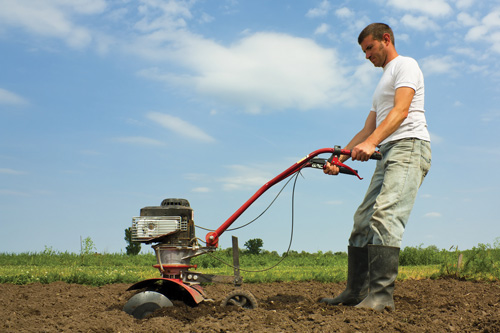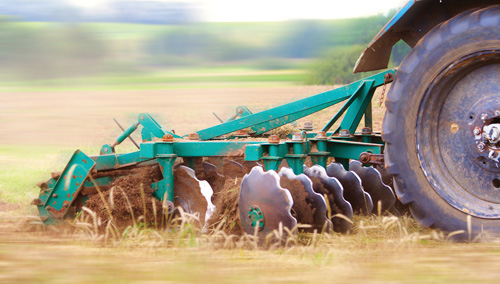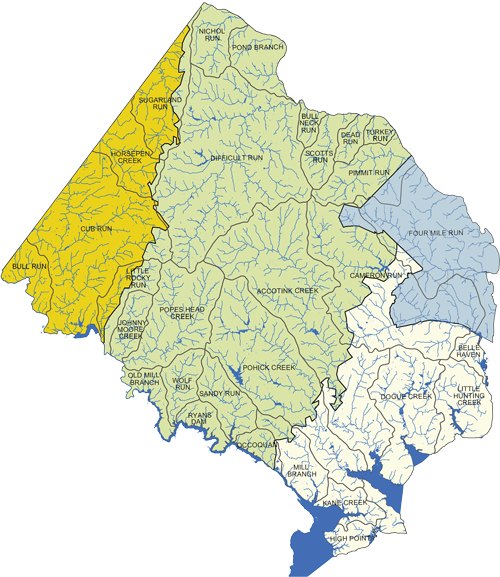
Protecting our environment, one stormwater practice at a time.
Soil Compost Amendments
Overview
A soil compost amendment is a stormwater practice that deeply tills compacted soil and restores the porosity by amending with compost.
Water on the ground soaks into the soil underneath by traveling through void spaces called pores between soil particles. This is called infiltration. When the soil is compacted, these void spaces become smaller. Compaction can occur during construction or by repeated pedestrian or vehicular use of the ground. Less void space means slower infiltration. When it rains on a compacted area, the water runs off instead of infiltrating into the soil.
There are many types of soils in Fairfax County. While some soils naturally infiltrate well, others do not, and can be improved by the use of soil compost amendments.
How Soil Compost Amendments Work
 Adding organic matter or compost to the soil reduces soil density and improves soil structure. Structure refers to the clumping together of soil particles. Soil with good structure is more porous and has better infiltration. Compost improves the health and productivity of the soil by adding a long-term source of nutrients and organic matter. The type of compost recommended will depend on the need of the soil based on a soil test.
Adding organic matter or compost to the soil reduces soil density and improves soil structure. Structure refers to the clumping together of soil particles. Soil with good structure is more porous and has better infiltration. Compost improves the health and productivity of the soil by adding a long-term source of nutrients and organic matter. The type of compost recommended will depend on the need of the soil based on a soil test.
Soil compost amendments can be used to:
- Increase the amount of water that infiltrates into the soil
- Reduce runoff from compacted soils
- Backfill terraced slopes to slow down runoff and improve infiltration
 The size and depth of a soil compost amendment is dictated by the volume of stormwater that the amendment proposes to manage, the current condition of the soil and the tools available to mix the compost into the soil below the surface. A soil compost amendment should have a minimum of two to four inches of compost incorporated six to ten inches below the surface. This can be accomplished using a rototiller. In order to amend the compost deeper into the soil, a subsoiler can be used. A subsoiler incorporates six to ten inches of compost to a depth of 18 to 24 inches. Though not considered a soil compost amendment, a compost blanket is an option to add nutrients and organic matter to the soil in lieu of fertilizer.
The size and depth of a soil compost amendment is dictated by the volume of stormwater that the amendment proposes to manage, the current condition of the soil and the tools available to mix the compost into the soil below the surface. A soil compost amendment should have a minimum of two to four inches of compost incorporated six to ten inches below the surface. This can be accomplished using a rototiller. In order to amend the compost deeper into the soil, a subsoiler can be used. A subsoiler incorporates six to ten inches of compost to a depth of 18 to 24 inches. Though not considered a soil compost amendment, a compost blanket is an option to add nutrients and organic matter to the soil in lieu of fertilizer.
Soil compost amendments are not recommended where:
- Existing soils have high infiltration rates
- The water table or bedrock is located within 1.5 feet of the soil surface
- Slope exceeds 10 percent.
Problem soils in Fairfax County include marine clay that may have unstable slopes and land slippage, high shrink-swell clays, poor foundation support and/or high water table conditions. There are also areas of naturally occurring asbestos. Please refer to the Digital Map Viewer at www.fairfaxcounty.gov/gisapps/DMV to identify these locations before digging.

How to maintain a soil compost amendment
In order to ensure the success of soil compost amendments, the following tasks should be undertaken in the first year:
- For the first six months, the site should be inspected at least once after each major storm event (½ inch of rainfall or more)
- Reseed amended soils that are bare or eroding and stabilize with vegetation
- Water once every three days for the first month, and then weekly during the first year (April through October) depending on rainfall
There are no major long-term maintenance needs associated with soil compost amendments, although the owners may want to de-thatch the turf every few years to increase permeability.
How To Obtain A Soil Test
The Virginia Tech Soil Testing Laboratory analyzes soil samples and provides recommendations to improve soil fertility. All Fairfax County public libraries have a supply of Virginia Tech soil testing kits. The kits have instructions on how to collect the samples and where to mail them for analysis. The fee for routine analysis is $10. A routine soil test package includes analysis for soil pH, phosphorous, potassium, calcium, magnesium, zinc, manganese, copper, iron and boron, along with fertilizer and lime recommendations for specified plants. Additional information on the Virginia Tech Soil Testing Lab is available at www.soiltest.vt.edu.
 FairFacts
FairFacts
- The 2011 official county soils map is available through the digital map viewer at www.fairfaxcounty.gov/gis/DMV.
- There are more than 100 named soil types in Fairfax County and more than 22,000 in the United States.
- There are three distinct physiographic regions in Fairfax County. The eastern part of the county is part of the Coastal Plain province, the central portion is part of the Piedmont Upland province, while the Triassic Basin province occurs in the west along the border with Loudoun County.
The information in this fact sheet is general in nature and is not intended to determine maintenance responsibility.
For more information, contact:
Department of Public Works and Environmental Services, Maintenance and Stormwater Management Division
10635 West Drive, Fairfax, VA 22030
703-877-2800, TTY 711
ContactMSMD@fairfaxcounty.gov

